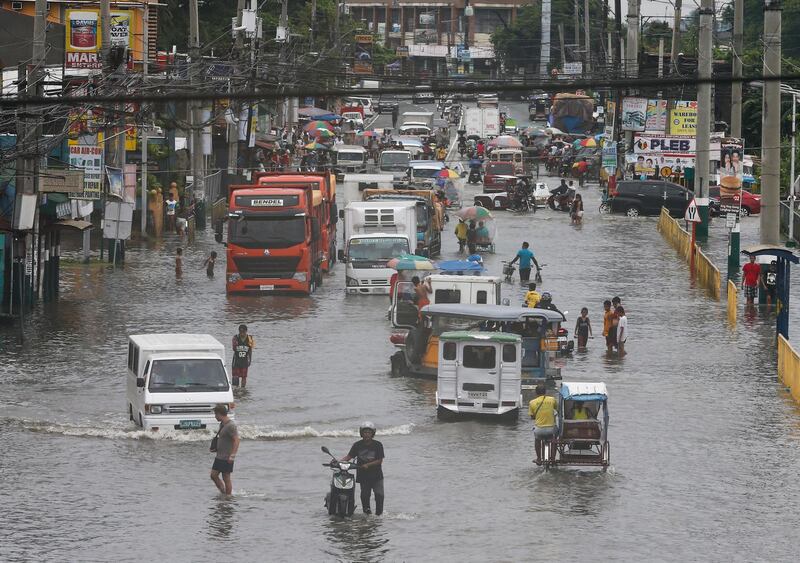Monsoon rains battered down on Manila this week as a tropical storm - the ninth this year - howled nearby.
Schools, courts and the senate were shut for two days; roads were flooded; public transport was affected.
It could have been worse.
That the Philippine capital is one big ocean wave away from disaster isn’t news to climate scientists or economists. After analyzing 393 cyclone-vulnerable coastal cities in 31 countries, World Bank economists have concluded that 40 percent of the burden of storm-surge catastrophes would fall on just three Asian cities - Manila, Karachi and Jakarta.
Unlike the former British rulers of Pakistan and the erstwhile Dutch masters of Indonesia, the Americans have left the Philippines with a viable alternative. The Clark Air Base played an important role during the Vietnam War. It stayed under American control until 1991.
But what the US left behind offers a chance to build something new and durable at least for the next 473 years. (The nearby volcano of Mount Pinatubo tends to erupt once in 500 years; the last blast was in 1991, hastening the American departure.)
The highest point in metropolitan Manila is 40 metres above sea level; in New Clark City, where office blocks are being constructed to move a host of government departments from the congested capital, the maximum elevation is 800 metres. (Even the lowest point is 54 metres above sea level.) Royal Pineda, the architect rushing to meet tight deadlines for construction of a sports complex ahead of next year’s South East Asian games, says the right metaphor for Clark is iCloud - a back-up for when Manila fails.
Clark should have been redeveloped long ago, agrees Vivencio Dizon. The Bases Conversion and Development Authority, which Dizon heads, has already tasted success with Fort William McKinley. Bonifacio Global City, the Manila financial and lifestyle district that’s replaced the old army base, was developed by tycoon Manuel Pangilinan’s Metro Pacific Investments, which sold it in 2002 to Campos Group and Ayala, among the handful of family-run conglomerates that control economic life in the Philippines.
_______________
Read more:
Philippines leads way on Asia-Pacific female economic participation
UAE's Filipino expats cash in with best exchange rates for a decade
_______________
Breaking the jinx of tycoons’ inattention toward Clark is Dennis Uy, a businessman from the home province of President Rodrigo Duterte. The president’s pal is now a big-league deal maker who has even managed to rope in as a partner the flagship investment arm of billionaire Henry Sy, the Philippines’ richest man. Last year, he bought the firm that’s building a $1 billion, 177-hectare commercial and business centre in Clark’s free-port zone.
There’s more investment coming. Chinese internet entrepreneur Jack Ma may set up a 20-hectare, fully automated warehouse next to the Clark airport for his Lazada Group’s e-commerce operations, if negotiations over lease rates conclude successfully.
For now, though, the Chinese are outgunned in Clark by the Koreans, who’ve been coming in droves after Asiana Airlines started a flight in 2003 between Incheon and Clark. What drew them initially was the opportunity to play golf on a course made famous by a young Tiger Woods. But now there’s also gambling at Widus Hotel and Casino, whose Korean owner Daesik Han will soon open a Marriott-branded hotel.
In the works: an integrated Widus resort. Meanwhile, more than two-fifths of the $7bn in exports from the free-port zone is on account of one South Korean chip maker. SFA Semicon started making embedded multimedia cards, used in smartphones and GPS systems, when it expanded its factory earlier this year.
Why do I think Clark will succeed when many other planned cities - from Putrajaya and Cyberjaya in Malaysia to Lavasa in India - have been failures? Clark’s most obvious draw is that it’s solving a real problem: lack of connectivity. The 2,300 hectares of dedicated airport land left by the Americans is five times the size of cramped Manila airport. But even with that advantage, Clark’s isn’t a mad “build-it-and-they-will-come” model, where vast empty infrastructure awaits tenants.
It’s only now that 158 international and 338 domestic flights are taking off every week from Clark that the plan to build a new terminal is being set in motion. The free-port zone, which includes the airport, is being developed first so it can serve as the nerve centre of the upcoming New Clark City, spread over an area six times bigger. Besides, Mr Dizon’s bases conversion authority has both the power and the capacity to execute large projects. The 949 business tenants get all their regulatory approvals and day-to-day services from Clark Development. Red tape is minimal, says Evan McBride, the CEO of Global Gateway Development, the builder now owned by Mr Uy.
Finally, the project is being impelled by both push and pull. Mr Duterte is promoting Clark, but for many of the 13 million residents of metro Manila, there’s enough attraction in the notion of putting a little distance between themselves and nature’s fury.
Bloomberg






